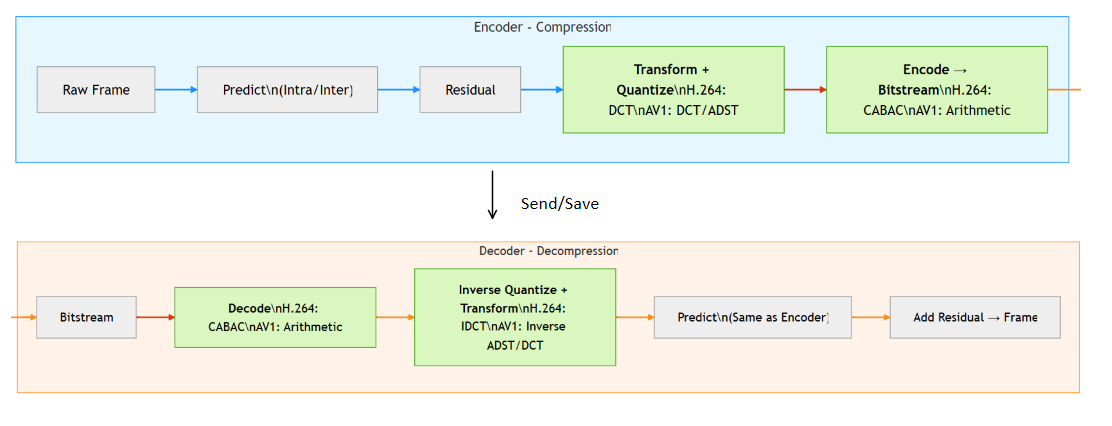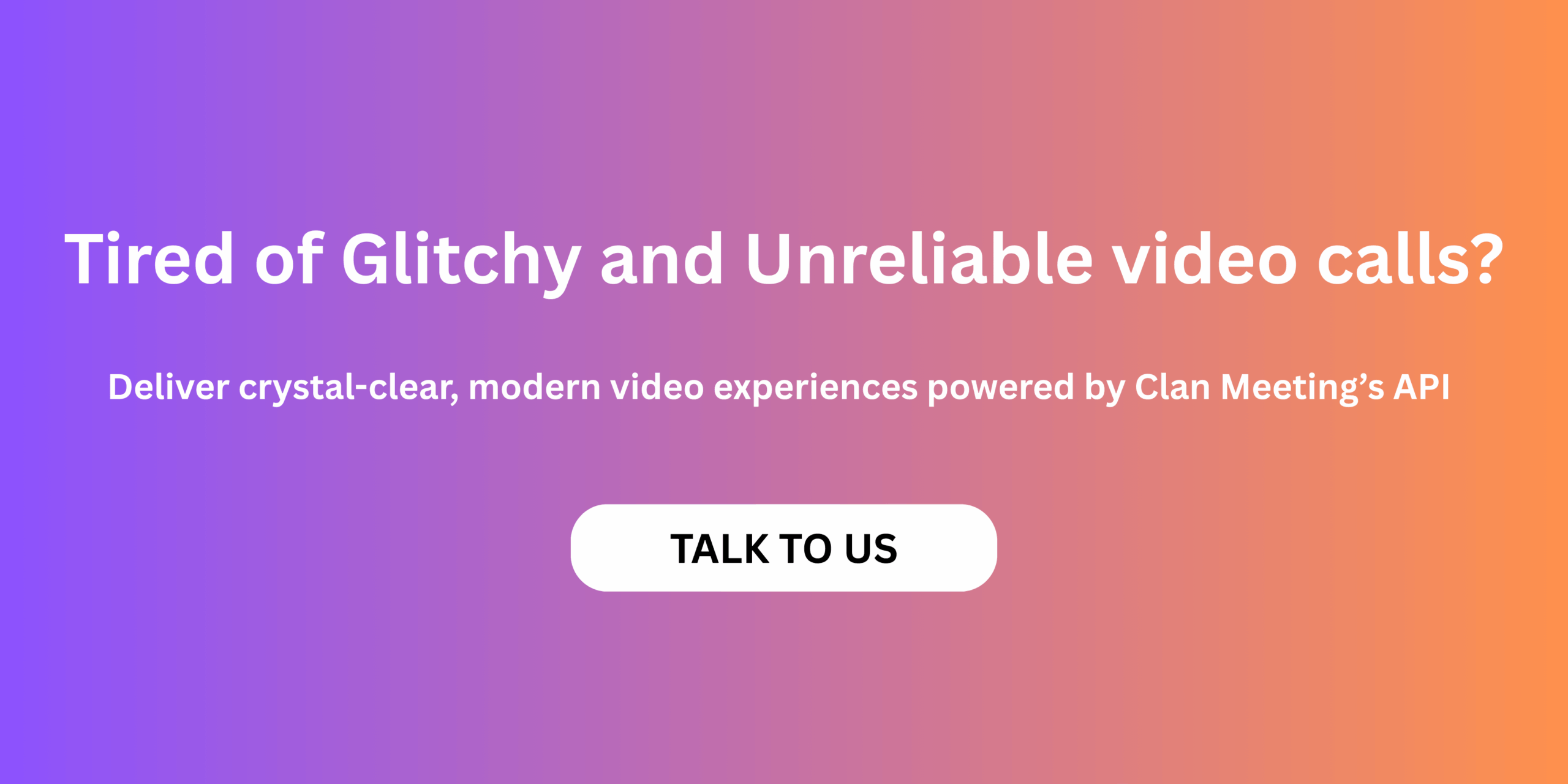Every developer who has tried embedding live video inside an app learns one thing fast - what looks simple on the surface, like just another API call is actually a series of invisible trade-offs - latency, bandwidth, CPU load, Quality under weak networks etc.
And each one depends on how well your video pipeline handles a fundamental layer - the codec.
Today, if you are building for real-time communication, whether it is candidate interviews, onboarding sessions, or internal meetings, the real question is AV1 vs H.264 - which codec actually delivers better results for live, in-app video calls?
This is not a theoretical discussion - it is the kind of decision that affects how users experience your product every single day.
Why the Codec Question Matters
A video codec is simply a compression algorithm that decides how raw video frames are encoded, transmitted, and decoded in real time.
H.264 (or AVC) has been the default for over a decade whereas AV1, a much newer codec from the Alliance for Open Media, promises dramatically higher efficiency - essentially the same quality at nearly half the bandwidth.
That difference matters when your users are scattered across the world some joining on corporate Wi-Fi and others on patchy mobile data.
When we started building Clan Meeting, we spent months benchmarking AV1 vs H.264 under different conditions - 3G networks, low-end Android phones, global relay routes and the findings were eye-opening.

How Video Codec Works
H.264 - The Workhorse That Built the Modern Video Internet
If AV1 is the new kid on the block, H.264 is the one that quietly runs everything behind the scenes. Nearly every major browser, device, and GPU supports it out of the box. It is stable, well-understood, and has a decade’s worth of optimization under its belt which makes H.264 real-time encoding the safest choice when you want predictable, low-latency performance.
It was designed in an era when CPUs were weaker and networks slower and it shows in how efficiently it runs on almost any hardware.
Here are the main reasons why teams still rely on H.264 -
- Hardware acceleration is universal
- Encoding and decoding are fast, even on older chips
- It integrates natively with all major WebRTC codecs and SDKs
- It maintains consistent video quality and bandwidth stability under fluctuating networks
However, there is a trade-off - efficiency.
H.264 consumes more bandwidth to achieve the same quality as newer codecs. In global deployments, that means higher data costs and slower adaptation to weak networks.
For example, a 720p stream might need 1 Mbps using H.264 but the same perceptual quality on AV1 could hold steady at 600 Kbps. While at small scale the difference is negligible, as the usage increases, the cost becomes quite significant.
AV1 - The Push Toward Efficiency and Future-Readiness
AV1 was built to solve the two biggest issues with legacy codecs - compression efficiency and licensing complexity.
Developed by the Alliance for Open Media (a consortium that includes Google, Netflix, and Amazon), it is royalty-free, meaning platforms can scale usage without paying patent pools.
But its real selling point is technical - AV1 achieves the same visual quality as H.264 at 30–50% lower bitrates. That is a big leap.
It means smoother calls on mobile networks, sharper video under poor connections, and lower server egress costs for API-based products. From our own early tests -
- Under stable Wi-Fi, AV1 consistently produced cleaner detail at lower bitrate
- On congested 4G connections, it adapted better to sudden drops in throughput
- The visual sharpness, especially for facial clarity, was noticeably higher in side-by-side comparisons
But the gains come with its own issues.
AV1 is computationally heavy especially for real-time encoding and without hardware acceleration, CPU usage can spike by 2–3×, increasing device temperature and battery drain. That is why most platforms adopt AV1 gradually as hardware support is still catching up to fully support this.
AV1 vs H.264 - What Really Happens in Real-Time Calls
Most video codec comparisons focus on file encoding or streaming benchmarks. But, live in-app video calls are different as you are not encoding once - you are encoding and decoding continuously at 30 frames per second on devices with unpredictable performance.
Here is how the two stack up in real-world WebRTC video scenarios -
H.264 | AV1 |
Reliable across every browser (Chrome, Safari, Edge, Firefox) | Delivers better quality at the same bitrate |
Consistent sub-300 ms end-to-end latency | Reduces bandwidth consumption significantly |
Encodes efficiently on CPUs with hardware acceleration | Handles fast motion (like gestures or screen share) more gracefully |
Less prone to overheating or hanging on mobile devise | Still needs careful optimization to keep latency low under software encode |
In other words , H.264 wins on universality and responsiveness whereas AV1 wins on efficiency and visual fidelity, especially under tough network conditions.
The right choice depends on who you are building for - if your user base includes older laptops, mid-range Androids, and mixed browsers, H.264 should remain your default. But, if you are optimizing for modern devices and global reach, AV1 becomes a real advantage.
Codec Efficiency - The Numbers Behind the Difference
Let’s look at the actual metrics from internal tests and public research -
Metric | H.264 | AV1 |
Bitrate (720p) | 1.0 Mbps | 0.6 Mbps |
Bitrate (1080p) | 2.5 Mbps | 1.4 Mbps |
VMAF Quality Score | ~85 | ~93 |
Encoding Complexity | Low | High (2–3× CPU) |
Device Hardware Support | ~95% of active devices | 65–70%, increasing annually |
Licensing | Patent-encumbered | Royalty-free |
WebRTC Real-Time Readiness | Mature | Improving rapidly |
For in-app video platforms, that 30 to 40% reduction in bitrate translates to measurable savings. Less bandwidth means lower infrastructure bills and smoother calls for users on unstable connections.
Codec Negotiation - Why You Need Both
In a real WebRTC architecture, you do not need to pick one codec and hope for the best. You can let both coexist and let the system decide dynamically. Modern signalling layers allow devices to negotiate codecs through SDP (Session Description Protocol).
So, if both endpoints support AV1, the call uses it automatically and if one device cannot handle it, it falls back to H.264 without breaking the session. This hybrid model solves the reach vs performance dilemma.
Platforms like Clan Meeting implement this natively.
Developers just specify a codec preference and the API intelligently optimizes per user and device. That flexibility is critical for HRTech SaaS platforms where users might join from anywhere and from any type of device.
The Cost and Experience Impact for HRTech SaaS
Codec decisions are rarely discussed in HRTech but when you run thousands of interviews or onboarding calls a month, the impact is quite evident.
AV1 maintains visual sharpness even at half the bitrate. Which means better facial cues and expressions - things that matter most in interviews. And for every hour of video, AV1 can save 30–50% in data usage which means lower operation costs.
A simple calculation will explain this -
Let's assume your platform handles 10,000 hours of video calls every month.
With H.264, streaming at an average of 1 Mbps, that adds up to roughly 4.5 terabytes of data transfer. While with AV1, which delivers the same visual quality at 0.6 Mbps, the data usage drops to about 2.7 terabytes - that's about 40% saving in bandwidth and that too without any compromise in video quality.
At scale, these savings translate directly into lower infrastructure bills and smoother user experiences.
The Transition Path - From Stability to Efficiency
Moving from H.264 to AV1 does not have to be a big shift.
Start by keeping H.264 as your baseline as it is proven, stable, and gives you low latency and broad compatibility across every browser and device.
Once that base is strong, start adding AV1 to places where it makes sense, including on newer hardware and modern browsers like Chrome, Edge, and Firefox that already support it.
After that, keep a watch on your KPIs such as frame rates, CPU load, call success rates, and overall latency. The information will let you know when your system can handle more AV1 traffic. As hardware acceleration becomes standard across chipsets, you can slowly move more calls to AV1 without breaking anything.
This gradual shift avoids any sudden disruptions and helps you transition to AV1 and unlock the bandwidth savings and reduced operational cost.
To Conclude..
AV1 vs H.264 is not a winner-takes-all debate but a progression from legacy stability to modern efficiency.
If reliability and reach are your top priorities, H.264 should be your choice but, if you want to cut costs, improve quality in poor networks, and prepare for the future, AV1 is the next step.
And the best approach is to design a dynamic system that’s support both and let your infrastructure decide dynamically which option one is a better choice for a given situation.
That is exactly how we have approached it at Clan Meeting by building a system that adapts in real time, using AV1 where it improves quality and cost, and H.264 where reliability matters most.
Frequently Asked Questions
1. What is the main difference between AV1 and H.264 video codecs?
The primary difference between AV1 vs H.264 lies in efficiency and hardware support. AV1 offers up to 30–50% better compression efficiency—meaning the same visual quality at lower bitrates—while H.264 provides broader compatibility and faster real-time performance. For live video calls, AV1 reduces bandwidth usage, and H.264 ensures universal reliability.
2. Is AV1 better than H.264 for real-time in-app video calls?
AV1 delivers higher quality at lower bandwidth, but it also demands more processing power. For real-time WebRTC applications, H.264 still performs better on older devices due to mature hardware acceleration. The ideal setup is hybrid: use AV1 where supported and fall back to H.264 when needed.
3. How does AV1 improve video quality and bandwidth efficiency?
TheAV1 codec uses advanced compression algorithms that predict motion and colour more efficiently than H.264. As a result, it can deliver HD-level clarity while consuming up to 40% less bandwidth. This makes AV1 ideal for global, mobile, or low-connectivity users in hiring or onboarding platforms.
4. Why do most video APIs still rely on H.264 despite AV1’s efficiency?
WhileAV1 codec efficiency is superior, its encoding complexity and partial hardware adoption limit real-time scalability. H.264 remains dominant because it runs smoothly on nearly all browsers and devices with consistent latency. As chipset manufacturers expand AV1 support, adoption is rapidly increasing.
5. How can developers integrate both AV1 and H.264 in WebRTC?
Modern WebRTC codecs support dynamic negotiation using SDP (Session Description Protocol). Developers can prioritize AV1 and automatically fall back to H.264 if the device or browser lacks support. Platforms like Clan Meeting already implement this logic—optimizing codec choice in real time for every session.
6. What are the real-world benefits of using AV1 in HRTech SaaS video platforms?
For HRTech SaaS applications that host interviews or onboarding calls, AV1 provides measurable advantages: sharper visuals, lower bandwidth costs, and smoother performance for users in regions with unstable internet. When paired with H.264 real-time encoding, it creates a flexible system that balances video quality and bandwidth perfectly.



